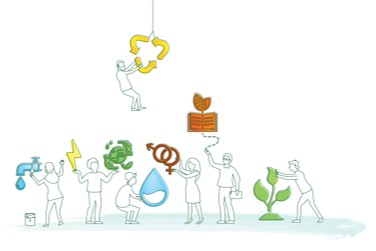Enterprise Profile
This type of enterprise offers technological solutions, specifically durable products, to both end consumers (B2C) as well as businesses (B2B) that help reducing costs for basic services. The product is based on sophisticated technology that oftentimes requires a level of guidance to ensure the clients understand how to use it.
Business Model Features
Enterprises within this typology offer their products wherever the target client is. As long as the product meets a need, the enterprise can be operating in a rural and/or urban context, as well as in a developing and/or developed market.
Given that the products are technology-driven, the pricing also targets more high- to middle-income customers than BoP communities. Nevertheless, there are always ways to be more inclusive through adding end-user financing services for lower income customers.
Context and Environment
Enterprises in this typology focus on selling in predominantly in urban areas. They usually target higher to middle income customers in the cities, where there is a larger population and higher willingness to pay for the product. Marginalized and BoP communities are less likely to buy the product due to the higher price compared to similar products in the market.
Impact Potential
The enterprise sells technology-driven products that create a positive, water-related impact on the end beneficiaries’ lives. Since the products are durable goods, they can be used continuously, and be distributed to a wide customer base, creating impact at scale. Especially if linked to reduction of greenhouse gas emissions, climate change mitigation impacts may be significant and can provide an opportunity to leverage climate financing.
Because the impact is somewhat indirect, it may be challenging to measure or even certify it, especially on an outcome level – unless there is a tracking mechanism in addition to the product. This could make it more challenging to appeal to donors, who require exact measurements of impact, but the scalability and reliability of the impact can be appealing to more risk-taking investors.
Potentially relevant SDG Targets
Water-related impact
SDG 6.1 By 2030, achieve universal and equitable access to safe and affordable drinking water for all.
SDG 6.2 By 2030, achieve access to adequate and equitable sanitation and hygiene for all and end open defecation, paying special attention to the needs of women and girls and those in vulnerable situations.
SDG 6.3 By 2030, improve water quality by reducing pollution, eliminating dumping and minimizing release of hazardous chemicals and materials, halving the proportion of untreated wastewater and substantially increasing recycling and safe reuse globally.
SDG 6.b Support and strengthen the participation of local communities in improving water and sanitation management.
Environmental impact
SDG 7.1 By 2030, ensure universal access to affordable, reliable and modern energy services.
SDG 7.2 By 2030, increase substantially the share of renewable energy in the global energy mix.
SDG 7.3 By 2030, double the global rate of improvement in energy efficiency.
Similarly, entrepreneurs could focus on areas in waste management or agriculture where high impact can be achieved by overcoming barriers rural end-customers face. Additionally, tackling to reduce climate change impacts through providing alternatives to high-polluting options can also achieve impact at scale.
Team and Experience
Since the product and services are technology-based, professional experience in this field as well as R&D is highly relevant – more than 5 years. While a systematic sales effort is a condition for success for these businesses, the technological details of the products and rather tech-savvy clients allow business to succeed with less marketing/sales and finance experience than might be expected (in some cases only 1-3 years of experience in this field). The enterprise has spent enough time developing its business model, especially in cases when the technology can easily be replicated by others or there are multiple alternatives already in the market.
Financial Profile
Despite the high technological standard of the company’s products, the initial capital expenditure requirements (CapEx) are still manageable with a decent revenue growth. In addition, the enterprise has a higher profit margin, due to its technological edge. This allows the company to reach the break-even point relatively early on.
The enterprise does not need to have a recurring revenue stream, given that the products can be used continuously, but can maintain customer loyalty, for instance, by providing free maintenance service.
What are your Financing Options?
Grant funding, especially R&D grants, can be found, if the enterprise’s products and services are based on new technology.
To raise grants from impact-driven donors, enterprises usually require to demonstrate a direct impact on the end-beneficiary level and be able to clearly measure it; for this typology, this can prove to be challenging.
Results-based finance (carbon credit)
For enterprises that offer products that are an alternative for a high-polluting one (e.g., solar cooking stove instead of coal or gas stove), carbon credits can be a viable source of financing. Once the enterprise proves that its offering reduces greenhouse gas emissions, it can get the reduction certified and sell it on the carbon credit market. This can help an enterprise achieve market-level profitability that might be difficult to reach when targeting BoP clients alone, and help it attract further investors.
Equity or alike (common stock, preferred equity, convertible note)
If the enterprise is able to demonstrate long-term financial viability with an adequate revenue growth that covers the upfront investment within a relatively short time frame, it is likely to attract equity or equity-like investors. Enterprises in their very early stages and without valuation might also be able to use convertible notes. Having professional financial experience will help finding equity for the enterprise.


